In a business world where the work-from-anywhere model is commonplace, a great Digital Employee Experience (DEX) can create a happier, healthier work culture, and ultimately make a huge difference, to an organization's bottom line.
Often, complex workplace technology within the digital workplace can hinder employee engagement and weaken employee sentiment, so it's crucial for businesses to have a digital employee experience strategy in place.
Not having the necessary means to measure digital employee experience can mean a high employee turnover, and this can cost organizations dearly, as we'll explain later.
In this guide, we'll reveal the best strategies and tools to empower employees to do their jobs from any location, and to create a lasting positive digital employee experience and a productive culture within the digital workplace.
Find out how your organization can solve experience problems for every user
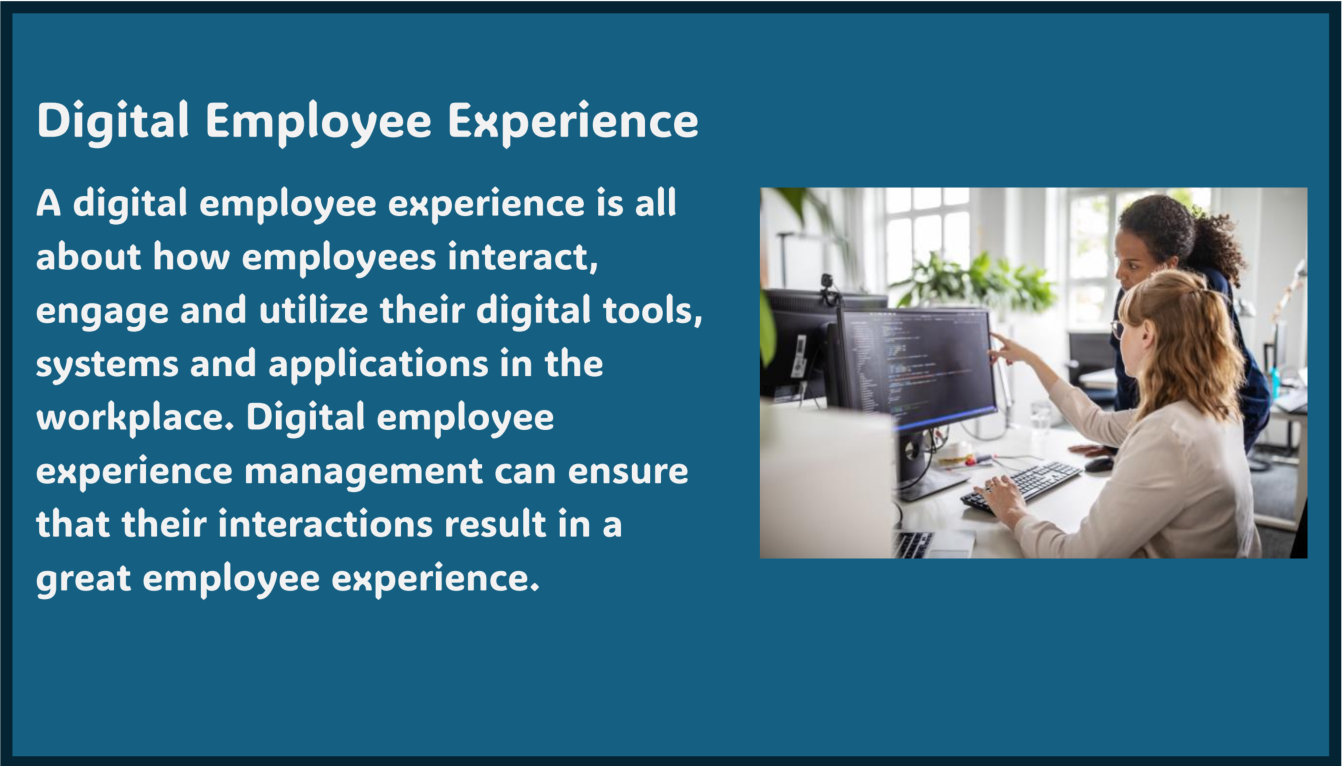
What exactly is digital employee experience?
The quality of employees’ touchpoints with their digital tools is the core of a seamless digital employee experience.
But you won't know what the pain points are, or who is struggling with new digital tools, existing devices and applications, and why, unless you measure your employees' digital experience.
Experience management solutions provide true end-to-end observability and deep remote user data for remote locations and enable employees to get the most out of the tools they work with.
However, a digital employee experience is not solely about how employees feel using the technology itself, but digital experience also takes into consideration how an organization's IT department works with the business, and with individual employees.
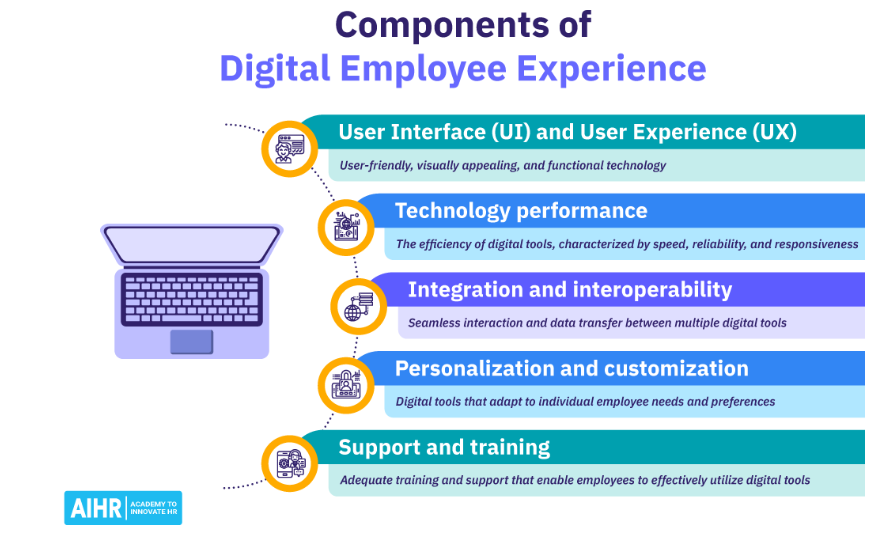
How efficiently can they resolve issues and respond to support tickets? How fast can they carry out service requests, deploy new technologies, collaborate with and train employees?
Some of the specific elements of employee experience management include:
-
Device, application and program reliability: Are applications regularly crashing? Do computers become so slow that they need to be restarted frequently? Is there seamless interoperability between work-issued mobile devices and company VPN?
-
Device, application and program performance: Are they fast enough and optimally configures to enable users to carry out their work efficiently?
-
Mobility and interoperability: Do all the devices enable employees to effectively work remotely?
-
Staying connected: Do programs, devices and applications enable employees to effectively collaborate with team members? Do they boost productivity and provide a positive end user experience?
Why is digital employee experience important?
As workflows and processes are different for every role in most companies, so too is every user's digital employee experience. DEX will vary between employees, but a great digital employee experience allows them to achieve key business outcomes that will help them, and their organization to thrive.
Digital tools can be either a barrier or a way to succeed. Removing digital friction and streamlining digital experiences, allows employees to be more satisfied, motivated and innovative from wherever they work.
Find out the true cost of poor employee experience
Here are some reasons why DEX is important, and a digital employee experience solution is a crucial element of every organization's digital transformation efforts.
-
Better employee retention. According to a HTC survey of over 600 people across a variety of roles and industries, around 36% of employees have considered quitting their jobs due to a poor digital employee experience.
Hiring new employees impacts a company's budget, not to mention the time taken to onboard and train, and the erosion of consistency and sustained office morale.
-
Better productivity and collaboration. Providing seamless access to any application or device from any location not only keeps employees connected, but with the right tools, every employee can focus on becoming more efficient, more productive, and stay up to date as their digital workspace evolves.
-
Improving customers' experience (CX). The benefits of a well-executed DEX can also extend to a company’s bottom line. Not having to deal with the frustration of tools that don't work empowers employees to better assist customers, leading to higher sales and profits.
Find out about digital experience vs customer experience. Read our comprehensive guide
Digital Experience Management: Things You Should Know
Creating an optimal digital employee experience
Every workplace has different digital employee experience goals, but an optimal DEX strategy can not only meet the needs of your workforce, but contribute significantly to your organization's success. Here are some best practices that can enhance employee experience, and streamline business processes.
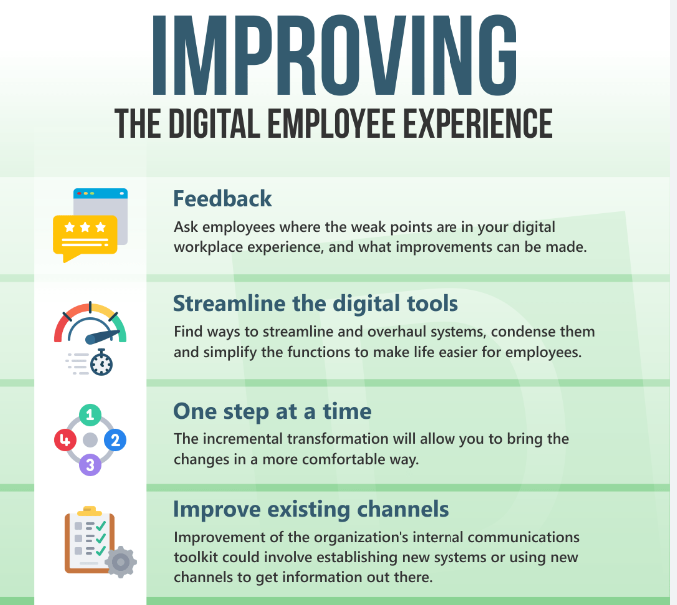
Image source: DeskAlerts
Prioritize employees' needs
Ensure that employees have the necessary tools they need to get their job done, as well as the support they need should they experience issues. This is particularly important for those team members working remotely.
Tailored dashboards
Employees all have different roles within the organization. Create personalized dashboards, tailored to individual roles and preferences. Use data analytics to better understand user behaviors and customize digital experiences.
Inclusivity and accessibility
Ensure everyone within your organization has easy access to the tools they need to carry out their work and connect with their fellow team members. Make sure applications are compatible with all types of employees' mobile devices.
When employees find it difficult to access information for example, or use instant messaging, or internal communications apps, it impacts their ability to carry out daily tasks.
Readily available training and support
Digital technology can be complex and overwhelming, so a positive digital experience relies on comprehensive training sessions that show team members how to work seamlessly with their relevant tools, devices and applications. Ensure swift access to technical support when issues arise.
Continuous feedback and improvement
Gather regular employee feedback by implementing surveys and scheduling meetings to gain insights into their digital experience. The best way to enhance employee experiences and make improvements is to find out in person what's working and what isn't.
Digital wellbeing programs
Data shows that many of us are now spending an average of almost 7 hours a day in front of a screen, so digital wellbeing is a vital element of an employees experience. Through tracking employee behavior, experience management solutions like RemoteInsight can help to implement policies that support a healthier work/life balance for remote and in-office staff.
Image source: Exploding Topics
Security awareness
In a digital environment, remote and hybrid working carries higher security risks, so it's important to educate employees about cybersecurity and the secure the use of digital tools to protect sensitive information.
Challenges of DEX
With its many moving parts and different considerations, a great DEX can be hard to achieve. Working with an experienced outsourced experience management partner like IR can alleviate these challenges.
Stakeholder buy-in and cost
Business leaders can be resistant to change, and approving budgets for new technology can be a significant hurdle. Additionally, employees will need ongoing assurances that the technology can make their work easier and their digital experience better with employee experience management.
Building the tech-stack
Building systems that integrate seamlessly to streamline, not complicate, your employees’ digital experience can be challenging, especially in a hybrid and remote modern workplace. With multiple devices and spread-out locations, a good user experience depends on a robust employee experience management solution.
Managing the digital employee experience with IR RemoteInsight
Employee experiences can only be enhanced and optimized by implementing specific experience management solutions. This involves the collection of data. After all, without data, you don't know what you don't know.
When a remote user reports a technical issue, the greatest difficulty is being able to collect the right information from the user’s perspective to properly analyze and resolve it. For example, if your contact center is experiencing dropped phone calls, you need to pinpoint exactly why, when and where this is happening.
Through data analytics, RemoteInsight enables a deeper level of insight into performance issues being experienced by users working from anywhere. It can track and manage technical issues like:
-
Video conferencing visual and audio issues
-
Devices or applications that aren't performing as they should
-
Unstable performance during video calls
-
Email synchronization problems
-
Internet and VPN connection problems
-
Instability opening documents and files
-
Password management difficulties
-
Inability to access cloud files
-
Being denied access to company websites and tools
Why you need RemoteInsight
In a remote working world, when you break down the key components of a great digital employee experience, it comes down to ease of usability, stability and reliability.
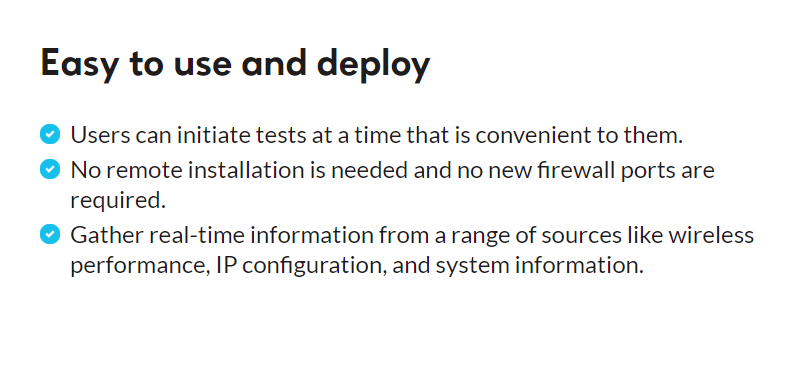
This is where RemoteInsight, the most comprehensive digital experience management solution on the market, becomes an enterprise organization’s most valuable tool.
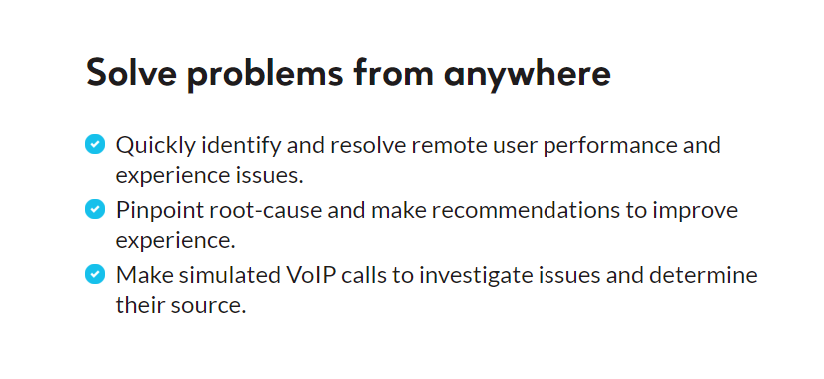
RemoteInsight was designed to give organizations deeper, more comprehensive insights into any performance issues experienced by users, no matter what their location.
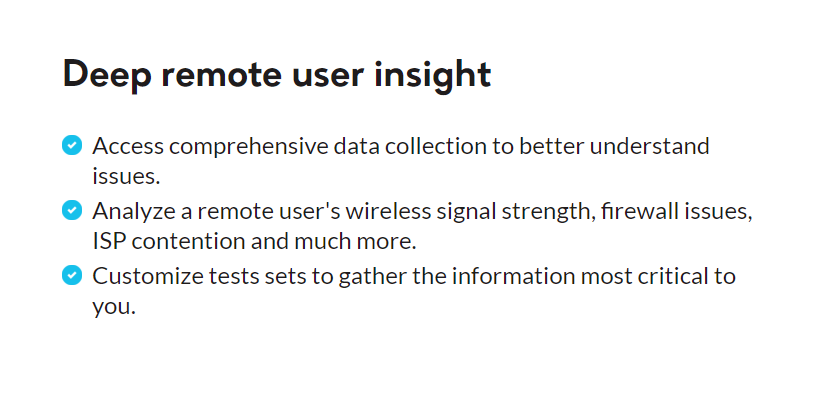
Employee satisfaction, better change management and cost reduction
Whether employees are adept at using technology, or not so much, their overall employee experience needs to be streamlined and trouble-free.
Employee satisfaction depends on experience management to make this happen. RemoteInsight can help you understand how employees are using their technology so that you can create an outstanding digital employee experience, even when something within an organization changes, such as the introduction of new applications or devices.
There is also a clear connection between employee experience and cost optimization. When you can evaluate employee experience through XLAs you can decrease employee turnover, and increase customer satisfaction by resolving customer issues faster.
Many factors influence a positive DEX, but with a world-class solution like RemoteInsight, you can not only create a more satisfied workforce but help improve business functions, and ultimately, your bottom line.
Learn more about RemoteInsight today





